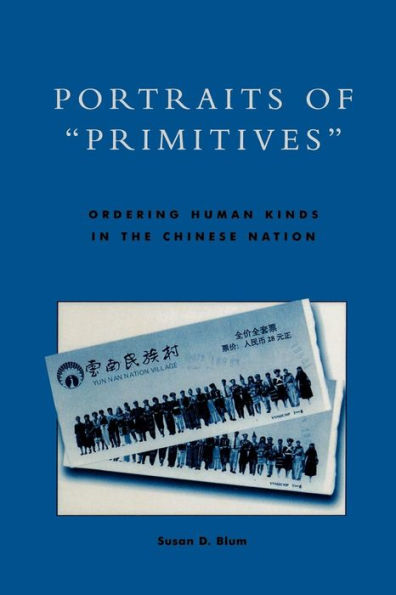Portraits of 'Primitives': Ordering Human Kinds in the Chinese Nation
Ethnicity is a highly politicized issue in contemporary China. Twentieth-century nation-building has been intimately involved with classification of China's fifty-five ethnic minorities and with fostering harmony and unity among nationalities. Officially sanctioned social science classifies the majority group, the so-called Han, at the pinnacle of modernization and civilization and most other groups as Oprimitive.O In post-socialist China, popular conceptions of self, person, and nation intersect with political and scholarly concerns with identity, sometimes contradicting them and sometimes reinforcing them. In Portraits of 'Primitives,' Susan D. Blum explores how Han in the city of Kunming, in southwest China, regard ethnic minorities and, by extension, themselves. She sketches Oportraits,O or cognitive prototypes, of ethnic groups in a variety of contexts, explaining the perceived visibility of each group (which almost never correlates with size of population). Ideas of 'Hanness' can be understood in part through Han desire to identify unique characteristics in ethnic minorities and also through Han celebration of the differences that distance minorities. The book considers questions of identity, alterity, and self in the context of a complex nation-state, employing methods from linguistic anthropology and psychological anthropology, as well as other forms of cultural analysis. Providing nuanced views of relationships among political, scholarly, and popular models of identity, this book will be an invaluable guide for those working in China studies, anthropology, and ethnic studies.
1119370242
Portraits of 'Primitives': Ordering Human Kinds in the Chinese Nation
Ethnicity is a highly politicized issue in contemporary China. Twentieth-century nation-building has been intimately involved with classification of China's fifty-five ethnic minorities and with fostering harmony and unity among nationalities. Officially sanctioned social science classifies the majority group, the so-called Han, at the pinnacle of modernization and civilization and most other groups as Oprimitive.O In post-socialist China, popular conceptions of self, person, and nation intersect with political and scholarly concerns with identity, sometimes contradicting them and sometimes reinforcing them. In Portraits of 'Primitives,' Susan D. Blum explores how Han in the city of Kunming, in southwest China, regard ethnic minorities and, by extension, themselves. She sketches Oportraits,O or cognitive prototypes, of ethnic groups in a variety of contexts, explaining the perceived visibility of each group (which almost never correlates with size of population). Ideas of 'Hanness' can be understood in part through Han desire to identify unique characteristics in ethnic minorities and also through Han celebration of the differences that distance minorities. The book considers questions of identity, alterity, and self in the context of a complex nation-state, employing methods from linguistic anthropology and psychological anthropology, as well as other forms of cultural analysis. Providing nuanced views of relationships among political, scholarly, and popular models of identity, this book will be an invaluable guide for those working in China studies, anthropology, and ethnic studies.
54.0
In Stock
5
1

Portraits of 'Primitives': Ordering Human Kinds in the Chinese Nation
256
Portraits of 'Primitives': Ordering Human Kinds in the Chinese Nation
256Paperback(New Edition)
$54.00
54.0
In Stock

Product Details
| ISBN-13: | 9780742500921 |
|---|---|
| Publisher: | Bloomsbury Academic |
| Publication date: | 12/13/2000 |
| Edition description: | New Edition |
| Pages: | 256 |
| Product dimensions: | 6.00(w) x 9.00(h) x 0.58(d) |
About the Author
What People are Saying About This
From the B&N Reads Blog
